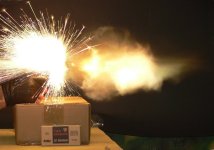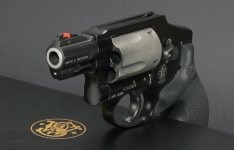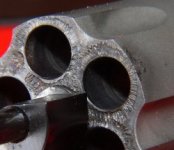Would this surprise me with 110 grain bullets ?
No. I am aware that 110 grain bullet loadings have been noted to flamecut the top strap on 686 revolvers. I really do not see this as anything new. I never saw such a photograph of this occuring with a Sc-Ti handgun though. Quite enlightening. Nice photo. I just wonder how many shots to get such a good photo. After seeing the results once, I would have stopped and unloaded.
Just to have some more tips, this is the correspondance between my buddy and S&W.
"Dear Sirs,
I was at the range to take pictures of muzzle flashes, shooting with the new line of Fiocchi “Black Mamba” defense cartridges (.380 Auto, 9x21, .40 S&W, .38 Spl, .357M and .45 ACP calibers).
To test the .38 and .357 caliber ammunition, I used my “old” S&W 340 PD.
The GFL Black Mamba .357 rounds are loaded with 110 grain bullets, and I was aware of the warning that “no less than 120 grs” ammunition should be used with this revolver, but I guessed that few rounds would be well tolerated by the handgun.
The attached Pic #1 shows the very FIRST round of GFL Black Mamba .357 Magnum - 110 grs.: an enormous shower of white sparks from the cylinder gap.
I checked the digital pictures only later on my PC, and in the meantime many shooters on the range wanted to try the little revolver and so a total of 34 rounds were fired.
After the shooting, routine cleaning the revolver, I found that the titanium cylinder surface was vastly damaged (Pic #2), and the erosion, as you can see in the picture #1, had begun with the very first round!
The revolver was purchased in 2003, but was used sparingly (about 500 rounds of .38 Spl Wad Cutter, Standard and + P, but no more than 10-15 .357 Magnum rounds).
Can you please give me some insight on why this level of damage has occurred to the handgun? A bad surface treatment of my 340 PD may be the reason of the damage I have witnessed, or ALL titanium cylinders are so “soft” that they cannot withstand 34 rounds of .357 Magnum ammunition with a standard 110 grain bullet?
Consider that the GFL Black Mamba loading is well within CIP specs and reportedly have had no problem in any other commercial handgun."
S&W answered
"Hi. the reason why we recommend you don't shoot .357 magnums under 120 grain in that gun is because the quick burning powder that is associated with the lighter grain bullets presents the possibility of eroding the face of the titanium cylinder. This only applies to the .357 magnum round, below 120 grain is fine for the .38 special."








